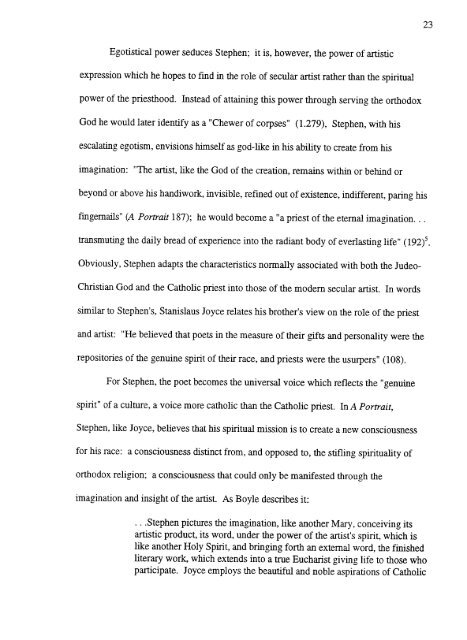Faubourg Saint Patrice - ScholarsArchive at Oregon State University
Faubourg Saint Patrice - ScholarsArchive at Oregon State University
Faubourg Saint Patrice - ScholarsArchive at Oregon State University
Create successful ePaper yourself
Turn your PDF publications into a flip-book with our unique Google optimized e-Paper software.
Egotistical power seduces Stephen; it is, however, the power of artistic<br />
expression which he hopes to find in the role of secular artist r<strong>at</strong>her than the spiritual<br />
power of the priesthood. Instead of <strong>at</strong>taining this power through serving the orthodox<br />
God he would l<strong>at</strong>er identify as a "Chewer of corpses" (1.279), Stephen, with his<br />
escal<strong>at</strong>ing egotism, envisions himself as god-like in his ability to cre<strong>at</strong>e from his<br />
imagin<strong>at</strong>ion: "The artist, like the God of the cre<strong>at</strong>ion, remains within or behind or<br />
beyond or above his handiwork, invisible, refined out of existence, indifferent, paring his<br />
fingernails" (A Portrait 187); he would become a "a priest of the eternal imagin<strong>at</strong>ion.. .<br />
transmuting the daily bread of experience into the radiant body of everlasting life" (192)5.<br />
Obviously, Stephen adapts the characteristics normally associ<strong>at</strong>ed with both theJudeo-<br />
Christian God and the C<strong>at</strong>holic priest into those of the modern secular artist. In words<br />
similar to Stephen's, Stanislaus Joyce rel<strong>at</strong>es his brother's view on the role of the priest<br />
and artist: "He believed th<strong>at</strong> poets in the measure of their gifts and personality were the<br />
repositories of the genuine spirit of their race, and priests were the usurpers" (108).<br />
For Stephen, the poet becomes the universal voice which reflects the "genuine<br />
spirit" of a culture, a voice more c<strong>at</strong>holic than the C<strong>at</strong>holic priest. In A Portrait,<br />
Stephen, like Joyce, believes th<strong>at</strong> his spiritual mission is to cre<strong>at</strong>e a new consciousness<br />
for his race: a consciousness distinct from, and opposed to, the stifling spirituality of<br />
orthodox religion; a consciousness th<strong>at</strong> could only be manifested through the<br />
imagin<strong>at</strong>ion and insight of the artist. As Boyle describes it:<br />
. . .Stephen pictures the imagin<strong>at</strong>ion, like another Mary, conceiving its<br />
artistic product, its word, under the power of the artist's spirit, which is<br />
like another Holy Spirit, and bringing forth an external word, the finished<br />
literary work, which extends into a true Eucharist giving life to those who<br />
particip<strong>at</strong>e. Joyce employs the beautiful and noble aspir<strong>at</strong>ions of C<strong>at</strong>holic<br />
23















